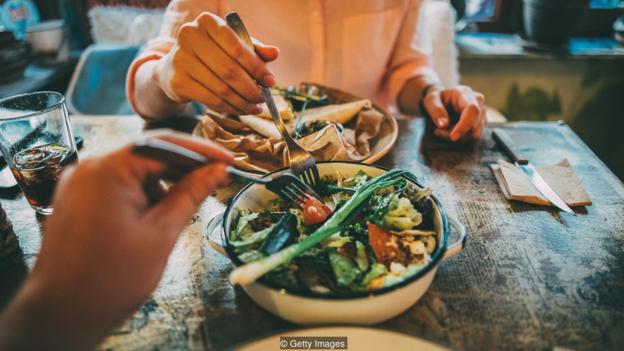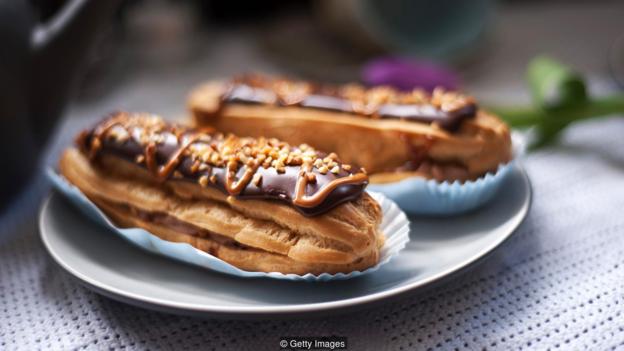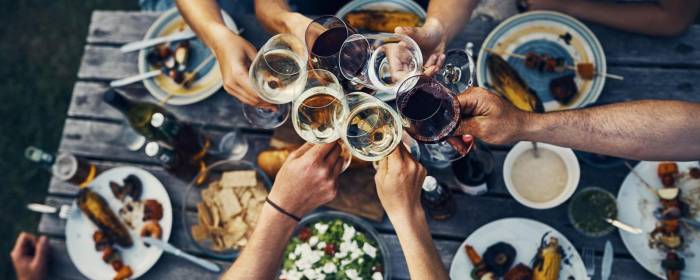How well do you remember the dinners you enjoyed with your friends, the ones where you left feeling as if you had eaten more than you could manage? Or in the opposite direction, the meals where you didn’t order a pudding, because nobody else did?
Perhaps you can blame social cues for eating too much or too little. Several decades of research shows that we eat more in company, and we follow what and how others eat.
But how exactly do our companions affect what we eat, and can we tap into these social influences to cut down on fats and sugar, and even lose weight?
A series of diary studies by health psychologist John de Castro in the 1980s alerted us to social influences in eating. By 1994, de Castro collected diaries of over 500 people recording their meals and the social context of how they ate them – in company, or alone.
To his surprise, people ate more in groups than when they were by themselves. Experiments by other scientists also found that people ate 40% more ice-cream and 10% more macaroni and beef in company than when alone. De Castro named the phenomenon ‘social facilitation’ and described it as the “single most important and all-pervasive influence on eating yet identified”.
What expands our palate when we eat with someone else? Hunger, mood, or distracting social interactions were all discounted by de Castro and other scientists. Studies reveal that we extend our meal times when we eat in a group, and we eat more in those extra minutes.

When you eat in company, you might be tempted to order bigger dishes to share (Credit: Getty Images)
Careful observation in a range of eateries showed that bigger groups do enjoy longer meals. And when meal time is fixed, larger parties no longer eat more than smaller ones. In a 2006 experiment, scientists gathered 132 people and gave them either 12 or 36 minutes to eat cookies and pizza. The participants ate alone, in pairs or in groups of four. Within each specific meal time, participants ate similar amounts regardless of their party size. This lab experiment provided one of the strongest evidence that longer meal time is key to larger meal sizes in social eating.
It seems very plausible that when we dine with our friends, we might linger, and therefore reach for yet another slice of cheesecake.
When we anticipate a group meal, we even order more food individually. This was revealed from observations in an Italian restaurant: the larger a dining party, the more pastas and desserts each diner ordered. Social meals appear to make us hungrier, and it appears that we decide that we will indulge even before we order. Such observations led C Peter Herman, a food scientist, to propose his ‘feast hypothesis’: indulgence is part and parcel of social meals, and that we socialise partially so that we can all eat more without the guilt of overindulgence.
Furthermore, the joys of eating together could be felt even if our companion is not real. In a Japanese study, individuals were asked to eat popcorn alone either in front a mirror or an image of a wall. Those who ate before a mirror enjoyed the popcorn more. Have you ever noticed how many restaurants have prominent mirrors?
But sometimes we do eat less in a company. Our drive to indulge can be tamed by the need to behave. We could manage our impression by eating according to social norms; or we might observe how others are eating and follow their lead, a behaviour called social modelling.
There are plenty of examples. Studies showed that obese children ate less in groups than when they ate alone. Overweight youths ate more chips and cookies when accompanied by an overweight youth but not when they ate with someone of normal weight. In university cafés, women ate fewer calories with men at their table, but ate more in women-only groups. And across the US, diners ordered more desserts when served by heavier waiters.

Even the physique of a waiter could influence the size of our order, research has suggested (Credit: Getty Images)
In the UK, diners added vegetables to their meals after posters were hung up in restaurants saying that most customers there ate vegetables. The sight of scattered sweet wrappers was also a powerful incentive for people to grab more chocolates.
One 2014 study revealed that such behaviour was found to have a moderate effect on food intake. Females tend to have stronger reactions to males, and we also tend to follow cues from people who are more like us. These patterns align with the notion that we pick up the cues of what is appropriate behaviour and eat accordingly.
So far, very few studies have considered why we might have evolved to eat according to social context. Perhaps heeding social norms and not eating more than others might have facilitated food-sharing among our hunter-gatherer ancestors. And eating like others could help children develop preferences for safe and nutritious foods, and therefore avoid potentially dangerous foods.
“We can learn by trial and error but that’s risky and can make us very ill. I think it could be very important from a young age to observe other people and eat like them, especially those who survive to old age because their food choices are likely to be very correct and appropriate,” says Suzanne Higgs, professor in the psychobiology of eating at University of Birmingham.
Unfortunately, as crisps and sweet treats are so readily available, our current eating norms can slide down a greasy slope. People tend to eat as their close social circles do, and they are less concerned with overeating if everyone eats more and gains weight together. In such circles, “we can fail to recognise obesity because it has become the majority”, says Sarah-Jeanne Salvy, associate professor of preventive medicine at the University of Alabama.

You might be able to resist dessert on your own - but what about when goaded by an eating partner (Credit: Getty Images)
Salvy studies social aspects of eating and obesity. “When told what they should weigh based on the BMI chart, some people are surprised and think that the chart was wrong to give impossible criteria,” says Salvy. A shift in social norms towards heavier weights can partially explain why many are gradually eating their way to obesity – the World Health organisation says as many as one billion people across the world are obese, including 340 million children.
Fortunately, healthy eating doesn’t require us to abandon friends who are bigger than us. Rather, we should first acknowledge that our eating habits are greatly shaped by social influences. Then we can be more aware of how we might act in this situation and take conscious control of our meals – perhaps skip that starter or desert, for example.
But if Herman is right that we plan overindulgence into our social meals and treat them like feasts, then consciously reining in our appetite would run against our nature. And unnatural restraint would become near impossible if the person across the table decides to order the cheesecake…
BBC
More about: Psychology
















































